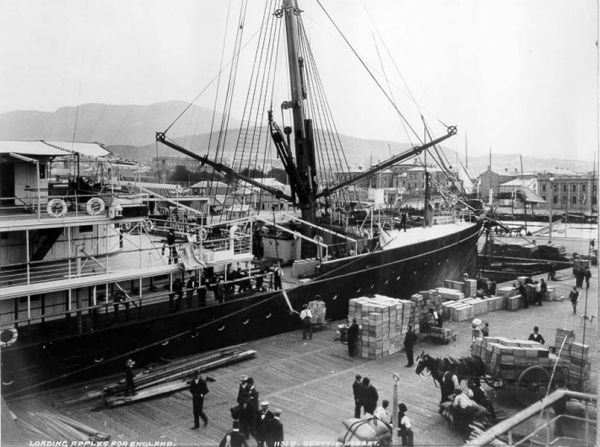 |
 |
|
Exports
Exports have a major impact on Tasmania's economic performance, as about half the state's products are sold either overseas or interstate. Since 1955–56, the value of the state's exports has consistently exceeded the value of its imports. This healthy balance of trade means that Tasmania is an important earner of export income for Australia. The main markets for Tasmania's exports in 2001–02 were: Japan 23 percent; ASEAN countries, such as Indonesia, Malaysia, and Thailand, 15 percent; Hong Kong 11 percent; South Korea 9 percent; Taiwan 6.5 percent; and the European Union 5 percent. Of the total value of exports (which in the twelve months to March 2003, was $2526 million) nearly 40 percent go directly overseas, with much of the 60 percent sent interstate also destined for overseas markets. While long-standing agricultural exports, such as fruit, vegetables, dairy products, wool and meat, are still important, Tasmania's key exports are now non-ferrous metals, woodchips and fertilisers. Non-ferrous metals – mainly zinc and aluminium, but also tin, lead and copper – comprised 32 percent of the value of merchandise exports in 2001. The search for export staples began in 1804 and remains an important feature of the development of the Tasmanian economy. Early contenders were timber, ships, wattle bark (for tannin), whale and seal fishery products. In 1812, the first cargo of wheat was exported to Sydney. By the mid-1820s, salted meat, seal and kangaroo skins, barley and potatoes were regularly exported, while wool dominated trade to Britain. In the 1830s, Port Phillip and South Australia provided new markets and there was an increase in the export of commodities such as vegetables, fruit, and livestock (mainly sheep and horses). The gold discoveries of the 1850s and 1860s boosted timber and food exports to other colonies, and gave impetus to the settlement of the north-west of the state. It was not until around 1880 that the value of Tasmania's exports first exceeded that of its imports. However, even with mineral exports increasing and technological changes enabling the export of meat, fruit and dairy products, the balance of trade continued to fluctuate. By 1900, when minerals and metals made up 63 percent of the value of exports, 42 percent were going to mainland Australia and New Zealand, 26 percent to the United Kingdom and 31 percent to other countries. Industrialisation during the first half of the twentieth century added processed zinc, confectionery, calcium carbide, textile products, paper pulp and newsprint to the list of exports, which by then included jams and hops among a broad range of agricultural products. During the 1970s, Japan became Tasmania's major overseas trading partner; apple exports declined; and woodchips, iron ore and seafood increased in importance. By the 1990s, Tasmania's reliance on products that had little or no added value was diminishing as new manufacturing industries such as those producing aluminium catamarans, transmission shafts and bearings, fertilisers and pharmaceuticals were established. However, 'diversification' and 'adding-value' continue to be key issues, as overseas exports remain concentrated in a handful of commodities and, except for ships and boats, all top ten exports (representing 70 percent of total value) are raw materials or food products. (See also Cereals, Sheep Farmers, and Shipbuilding.) Further reading: R Hartwell, The economic development of Van Diemen's Land 1820–1850, Melbourne, 1954; Tasmanian year book 1998 and 2000; Tasmanian budget papers: Budget paper number 1 and The Tasmanian economy 1983–84 to 2002–03; Statistics of Tasmania, 1837–1924; Australian Bureau of Statistics reports on the Tasmanian economy. Heather Felton |
Copyright 2006, Centre for Tasmanian Historical Studies |
